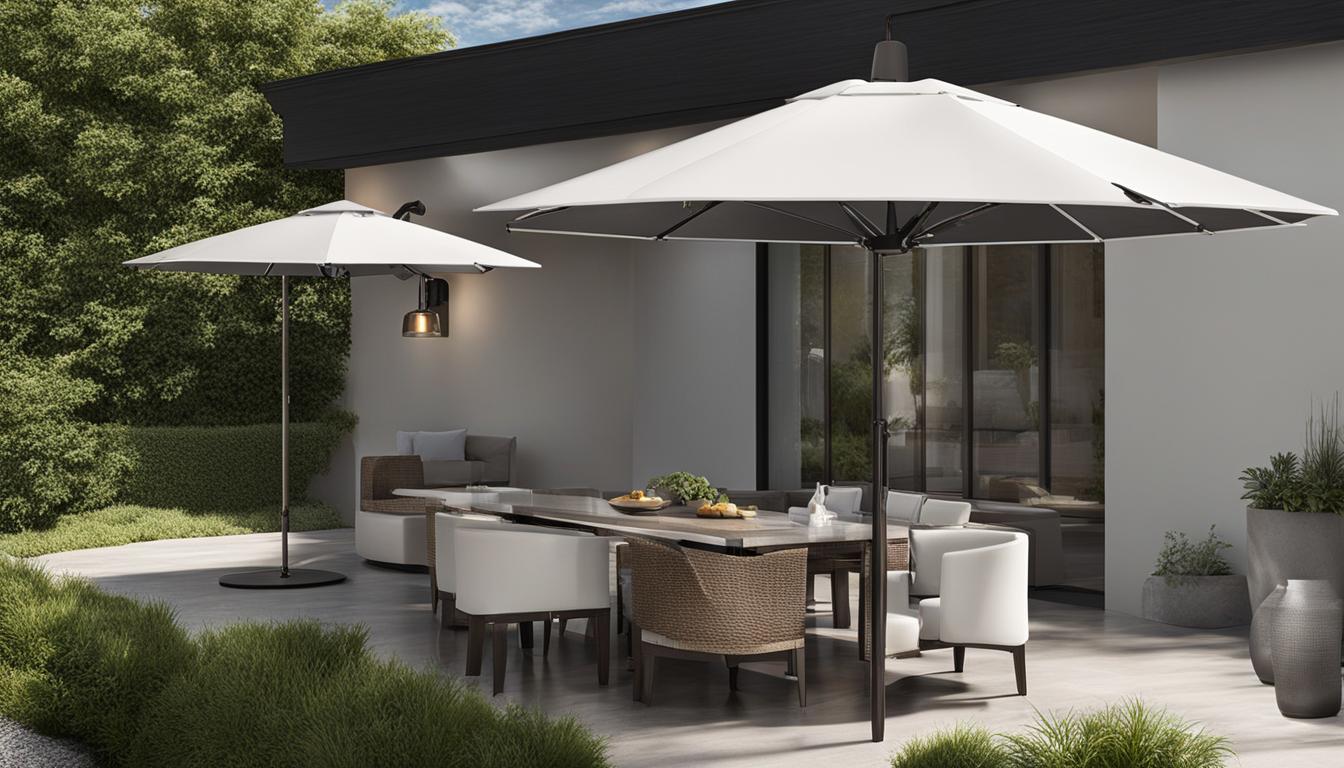Comparing Different Materials for Durability and Maintenance for Patio Umbrella

When it comes to choosing a patio umbrella, the material you select is crucial. You not only want it to look great in your outdoor space, but it also needs to withstand various weather elements, such as wind, rain, and sun exposure. Additionally, proper maintenance is essential to ensure its longevity. In this article, we’ll discuss the importance of comparing different materials for patio umbrellas in terms of durability and maintenance.
By the end of this article, you’ll have a better understanding of the various materials to consider, their pros and cons, and how to maintain them properly.
Key Takeaways
- Choosing the right material is crucial to ensure the longevity of your patio umbrella
- Factors to consider when selecting a material include durability and maintenance requirements
- Proper maintenance is essential to keep your patio umbrella in top condition
- Weather conditions can greatly affect the durability of patio umbrella materials
- Eco-friendly materials are available for those environmentally conscious individuals
Assessing the Durability of Outdoor Umbrella Materials
When it comes to selecting the right material for your outdoor umbrella, durability is a key factor. You want a material that can withstand the elements and last for years to come. Let’s take a closer look at some of the most commonly used materials for patio umbrellas and assess their durability.
Aluminum
Aluminum is a popular choice for outdoor umbrellas, thanks to its lightweight and rust-resistant properties. It’s also durable and can withstand strong winds. However, it’s important to note that prolonged exposure to UV rays can cause the powder coating on the aluminum to fade or peel.
Wood
Wood is a classic and stylish option for patio umbrellas. It’s durable, but its lifespan can vary depending on the type of wood used. Hardwoods such as teak and balau are known for their strength and resistance to moisture and insects, while softwoods such as pine are more susceptible to damage from the elements.
Polyester
Polyester is a common material used for umbrella canopies. It’s lightweight and easy to clean, but its durability can vary greatly depending on the quality of the fabric. High-quality polyester can withstand UV rays and resist fading, while lower-quality polyester may fade and deteriorate more quickly.
Acrylic
Acrylic is a durable and long-lasting material commonly used for umbrella canopies. It’s resistant to fading and UV damage, making it a great choice for sunny outdoor spaces. However, it’s important to note that acrylic can be prone to mildew if not properly cared for.
Fiberglass
Fiberglass is a strong and flexible material that can withstand strong winds and resist corrosion. It’s also lightweight, making it a great option for larger umbrellas. However, fiberglass can be more expensive than other materials and may require more maintenance to keep it looking like new.
As you can see, each material has its pros and cons when it comes to durability. Consider your specific needs and budget when selecting the right material for your outdoor umbrella.
Maintenance Tips for Your Patio Parasols
Keeping your patio umbrella well-maintained is essential for its longevity, ensuring it remains durable and functional throughout the year. Here are some maintenance tips for your outdoor parasol:
- Clean your parasol: Regularly cleaning your patio umbrella will keep it free from dirt, dust, and pollen. Use a soft-bristled brush or a microfiber cloth to wipe the surface of the umbrella canopy. For deeper cleaning, use a solution of mild soap and lukewarm water, then rinse with a hose.
- Maintain the frame: The frame of your outdoor parasol can also accumulate dirt and debris. Clean it regularly with warm water and a mild detergent, then rinse and dry it properly.
- Store it properly: When not in use, store your patio umbrella in a dry, shaded area. This will prevent fading from prolonged exposure to sunlight and protect it from damage caused by harsh weather conditions.
- Protect it from extreme weather: If you live in an area with strong winds, remove the umbrella canopy and store it indoors during storms. This will prevent the umbrella from toppling over and getting damaged.
- Apply a protective coating: Applying a protective coating to your patio parasol will help to extend its lifespan. Fabric protectors or UV-resistant sprays are available in the market and offer good results in safeguarding your outdoor parasol.
By following these tips, you can ensure that your patio umbrella stays in good condition for many years to come. Proper maintenance is key to enjoying your outdoor space and protecting your investment.
Choosing the Right Material for Your Outdoor Parasol
Now that you understand the importance of durability and maintenance, it’s time to choose the right material for your outdoor parasol. The material you select will impact the longevity and overall look of your outdoor space.
When selecting a material for your patio umbrella, there are various factors to consider, such as:
- Climate and weather patterns in your area
- The aesthetic you are going for
- Your budget
- The level of maintenance you are willing to commit to
Here are some common materials used for patio umbrellas and their features:
| Material | Features |
|---|---|
| Aluminum | Durable, lightweight, and rust-resistant. Can withstand harsh weather conditions. Requires minimal maintenance. Comes in a range of colors and finishes. |
| Wood | Classic and timeless look. Can be made from teak, bamboo, or other woods. Durable and sturdy, but heavy. Requires regular maintenance and protection from weather elements. |
| Steel | Strong and durable material. Residential and commercial grade options available. Can withstand inclement weather, but requires regular maintenance to prevent rusting. |
| Polyester | Water-resistant and affordable material. Available in a variety of colors and patterns. Easy to clean and maintain, but may fade with prolonged sun exposure. |
| Acrylic | Soft and breathable fabric. Resistant to fading and mildew. Available in a variety of colors and patterns. Requires minimal maintenance. |
Ultimately, the material you select will depend on your specific needs and preferences. Consider the aesthetics of your space, the weather patterns in your area, and the amount of maintenance you are willing to commit to.
Now that you’ve selected your material, it’s important to properly maintain your patio umbrella to ensure its longevity. In the next section, we’ll provide you with tips for maintaining different umbrella materials.
Comparing durability and maintenance of common umbrella materials
When choosing a patio umbrella, it’s important to consider the durability and maintenance requirements of different materials. Here, we’ll compare the most commonly used materials for outdoor umbrellas and provide insights on their longevity and upkeep.
| Material | Durability | Maintenance |
|---|---|---|
| Acrylic | Durable, fade-resistant, and water-repellent. | Requires regular cleaning with mild soap and water. Not recommended for windy areas as it can catch the wind easily. |
| Polyester | Durable and water-resistant, but fades over time. | Requires regular cleaning with mild soap and water. Not recommended for windy areas as it can catch the wind easily. |
| Olefin | Durable and fade-resistant, but can be prone to mold and mildew. | Requires regular cleaning with mild soap and water. Avoid leaving it wet to prevent mold growth. |
| Sunbrella | Durable, fade-resistant, and water-repellent. | Requires regular cleaning with mild soap and water. Not recommended for windy areas as it can catch the wind easily. |
| Wood | Elegant and sturdy, but requires maintenance to prevent rot and insect damage. | Requires sealing and staining regularly to prevent damage from moisture and insects. |
| Aluminum | Durable and lightweight, but can be prone to rust and corrosion. | Requires occasional cleaning with mild soap and water. Apply a coat of wax to prevent rust formation. |
| Fiberglass | Durable and flexible, but can be heavy and expensive. | Requires occasional cleaning with mild soap and water. Avoid leaving it wet to prevent mold growth. |
As you can see, each material has its own strengths and weaknesses in terms of durability and maintenance requirements. Consider your specific needs and the weather conditions in your area when selecting the best material for your patio umbrella.
Tips for Maintaining Different Umbrella Materials
Maintaining your patio umbrella can improve its longevity and keep it looking great for years to come. However, each material requires specific care to ensure it stays in its best condition. Here are some tips for maintaining different umbrella materials:
Acrylic Umbrellas
Acrylic umbrellas are a popular choice due to their vibrant colors and resistance to fading. To keep them looking their best, use a mild soap and water solution to clean any dirt or stains. Rinse thoroughly with water and let it air dry.
Polyester Umbrellas
Polyester umbrellas are durable and resistant to water. However, they are prone to fading over time. To protect the material from fading and mildew growth, it’s important to clean it regularly. Use a mild detergent and gently scrub the umbrella with a soft brush. Rinse thoroughly with water and let it air dry in a shaded area.
Wooden Umbrellas
Wooden umbrellas are a classic and elegant option. To maintain their beauty, they require regular cleaning and sealing. Use a soft brush to remove any dirt or debris. Then, apply a wood sealer to protect it from water damage and prevent cracks.
Aluminum Umbrellas
Aluminum umbrellas are lightweight and resistant to corrosion. Clean them regularly with a mild detergent and non-abrasive sponge. Avoid using harsh chemicals or abrasive materials, as these can scratch the surface.
Fiberglass Umbrellas
Fiberglass umbrellas are strong and durable, making them a great choice for windy areas. They are easy to maintain and require only occasional cleaning with a mild detergent and water. Avoid using abrasive materials to clean the material, as this can scratch the surface.
Table comparing maintenance requirements of different umbrella materials
| Material | Cleaning | Sealing | Protecting |
|---|---|---|---|
| Acrylic | Mild soap and water | N/A | N/A |
| Polyester | Mild detergent and soft brush | N/A | Protect from fading and mildew growth |
| Wood | Soft brush | Wood sealer | Protect from water damage and prevent cracks |
| Aluminum | Mild detergent and non-abrasive sponge | N/A | Avoid harsh chemicals or abrasive materials |
| Fiberglass | Mild detergent and water | N/A | Avoid abrasive materials |
Table showcasing the maintenance requirements of different umbrella materials.
Follow these tips to keep your patio umbrella in great condition for years to come. By taking good care of your umbrella, you’ll enjoy its shade and protection from the sun for many outdoor gatherings to come!
Assessing the Impact of Weather on Umbrella Materials
When purchasing a patio umbrella, it’s essential to consider its ability to withstand various weather conditions. The type of material used in the umbrella’s design plays a significant role in its durability against harsh weather elements. In this section, we’ll explore how different umbrella materials hold up against different weather conditions to help you make an informed decision.
Rain
One of the most common weather conditions that outdoor umbrellas face is rain. If an umbrella is not made from waterproof materials, it can quickly become damaged and unusable. Here’s how different materials stack up against rain:
| Umbrella Material | Durability Against Rain |
|---|---|
| Polyester | Water-resistant but not waterproof |
| Acrylic | Waterproof and durable against rain |
| Olefin | Waterproof and UV-resistant |
| Sunbrella | Waterproof and fade-resistant |
As you can see, materials such as acrylic, olefin, and Sunbrella are some of the best options for umbrellas that will be exposed to rain. These materials not only provide excellent durability against rain but also offer resistance against UV radiation, fading, and mildew growth.
Wind
Another factor to consider when purchasing a patio umbrella is its ability to withstand high winds. Wind-resistant umbrellas are designed to flex and bend under pressure without breaking or being uprooted. Here’s how different materials fare against wind:
| Umbrella Material | Durability Against Wind |
|---|---|
| Aluminum | Lightweight and can be bent by strong winds |
| Wood | Sturdy but can be damaged by strong winds |
| Fiberglass | Flexible and durable against strong winds |
As shown above, fiberglass is an ideal material for umbrellas that will be exposed to high winds. It’s both flexible and durable, meaning it can withstand the pressure of strong winds without breaking or being uprooted. On the other hand, aluminum and wood umbrellas are not the best options for windy areas as they can easily be damaged in such conditions.
Sun Exposure
Umbrellas that are exposed to sunlight for extended periods can fade and become brittle over time. UV-resistant materials are designed to withstand the sun’s rays and maintain their color and durability. Here’s how different materials hold up against sun exposure:
| Umbrella Material | Durability Against Sun Exposure |
|---|---|
| Polyester | Fades and deteriorates quickly when exposed to the sun |
| Cotton | Fades and deteriorates quickly when exposed to the sun |
| Acrylic | Resistant to fading and holds up well against the sun’s rays |
| Sunbrella | Resistant to fading and UV-damage |
As you can see, acrylic and Sunbrella are ideal materials for umbrellas that will be exposed to the sun for extended periods. They’re resistant to fading and UV-damage, which ensures their long-term durability and appearance. Conversely, polyester and cotton umbrellas are not the best options for sun-exposed areas as they can quickly fade and deteriorate.
By assessing the impact of weather on different umbrella materials, you can select the best option for your outdoor space. Be sure to consider the specific weather conditions in your area and choose a material that provides the necessary durability and resistance to maintain your umbrella’s longevity.
Eco-Friendly Options and Their Maintenance Practices
For those who prioritize sustainability, there are several eco-friendly materials available for patio umbrellas. These materials typically have a lower environmental impact and require specific maintenance practices to maintain their longevity.
Bamboo
Bamboo is an eco-friendly option as it is fast-growing and renewable. However, it is not as durable as other materials and requires gentle maintenance to avoid damage. To maintain bamboo patio umbrellas, avoid using harsh chemical cleaners, and clean with a soft cloth and gentle detergent. Store the umbrella in a dry, cool place to prevent moisture damage.
Recycled polyester
Recycled polyester is made from post-consumer plastic bottles and is a sustainable option. It is also durable and resistant to UV rays and water. To maintain a recycled polyester patio umbrella, clean it regularly with a soft cloth and mild detergent. Store it in a dry, cool place when not in use.
Organic cotton canvas
Organic cotton canvas is grown without harmful pesticides and is biodegradable, making it a sustainable choice. It is also water-resistant and durable, but it requires gentle care to prevent damage. To maintain an organic cotton canvas patio umbrella, avoid using harsh chemical cleaners and clean it with a soft cloth and mild detergent. Store it in a dry, cool place.
Conclusion
Eco-friendly materials are a great option for those who want to prioritize sustainability in their outdoor space. However, they do require specific maintenance practices to ensure their longevity. By following the tips provided above, you can enjoy a durable and well-maintained eco-friendly patio umbrella.
Selecting the Best Patio Umbrella Material and Maintenance Practices
When it comes to selecting the best patio umbrella material, there are a few key factors to consider. First and foremost, you need to evaluate the durability of the material. How well will it hold up against weather conditions, such as rain, wind, and sun exposure? You should also take into account the maintenance requirements of the material. Will it require frequent cleaning or special maintenance practices?
Based on these factors, you can narrow down your options to materials that best suit your needs. For example, if you live in an area with lots of rain, a material that is water-resistant and dries quickly, such as polyester or acrylic, might be best for you. If you are concerned about the environmental impact of your umbrella, you might consider eco-friendly options like bamboo or organic cotton.
Once you’ve selected the best material for your patio umbrella, it’s important to follow proper maintenance practices to ensure its longevity. Here are some tips:
- Clean it regularly: Dirt and debris can accumulate on your patio umbrella, causing it to look dingy and even causing damage over time. Depending on the material, you can use a mild soap and water or a specialized cleaner. Be sure to rinse thoroughly to avoid any soapy residue.
- Store it properly: When not in use, it’s important to store your patio umbrella correctly. This means keeping it in a dry, covered area to prevent moisture from accumulating and causing damage.
- Inspect it often: Regularly check your umbrella for any signs of wear and tear. Look for things like frayed edges or broken parts. Catching and repairing these issues early can prevent more extensive damage later on.
- Handle it with care: When opening or closing your patio umbrella, be gentle and avoid any jerky movements. This will prevent unnecessary wear and tear on the material and the moving parts.
By selecting the best material for your patio umbrella and following these maintenance practices, you can ensure that your outdoor parasol will last for many seasons to come.
Conclusion
Choosing the best material for your patio umbrella is crucial to ensure its longevity. By assessing the factors that influence durability and maintenance, you can make an informed decision that meets your specific needs. Remember to consider the weather impact of each material and opt for eco-friendly options whenever possible.
Once you’ve selected your material, it’s essential to follow the recommended maintenance practices. From cleaning to storage, taking care of your outdoor parasol will help extend its lifespan. Be sure to follow the specific tips provided for each material to ensure optimal maintenance.
With the information and insights provided in this article, you can confidently select the best patio umbrella material and maintenance practices for your outdoor space. Enjoy your durable and well-maintained parasol for years to come.
FAQ
What materials are commonly used for patio umbrellas?
The most commonly used materials for patio umbrellas are polyester, acrylic, aluminum, wood, and fiberglass.
How do I assess the durability of outdoor umbrella materials?
When assessing the durability of outdoor umbrella materials, consider factors such as resistance to wind, rain, and sun exposure, as well as the overall construction and quality of the material.
What are some maintenance tips for patio parasols?
To maintain your patio parasol, regularly clean it with mild soap and water, store it in a dry and covered area when not in use, and avoid leaving it open during harsh weather conditions.
How do I choose the right material for my outdoor parasol?
When choosing the right material for your outdoor parasol, consider factors such as durability, maintenance requirements, aesthetic preferences, and budget.
How do different umbrella materials compare in terms of durability and maintenance?
Polyester and acrylic are generally more durable and low-maintenance, while wood and aluminum require more attention to prevent damage and maintain their appearance. Fiberglass offers a good balance of durability and ease of maintenance.
What are some specific maintenance tips for different umbrella materials?
For aluminum umbrellas, regularly check for rust and clean with a mild detergent. Wood umbrellas should be sealed with a waterproof finish and protected from excessive moisture. Fiberglass umbrellas require regular inspection of the joint areas for any signs of wear or damage.
How does weather impact umbrella materials?
Different weather conditions can affect umbrella materials differently. Rain can cause fabric to stretch and lose its shape, while wind can damage the structure. Sun exposure can fade and deteriorate materials over time.
What are some eco-friendly options for patio umbrella materials?
Some eco-friendly options for patio umbrella materials include recycled polyester and sustainably sourced wood. These materials have minimal environmental impact and can be responsibly maintained.
How do I select the best patio umbrella material and maintenance practices?
To select the best patio umbrella material, consider your specific needs, preferences, and environmental concerns. Ensure that the maintenance practices align with your ability to regularly care for the umbrella and its material.
- Crafting a Dream Patio with Pavers - November 26, 2023
- DIY Patio Paver Construction - November 24, 2023
- Creating Stunning Patios with Pavers - November 21, 2023


